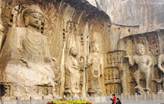Asia
Japan atom plant worker received high radiation
Updated: 2011-03-24 07:06
(Agencies)
VIENNA - One of the workers struggling to avert a disaster at Japan's crippled nuclear plant was exposed to a high radiation dose that may increase the risk of cancer, a UN atomic agency official said on Wednesday.
| ||||
High levels of radioactive iodine and caesium were measured close to water discharge points at the Fukushima power plant, "before dilution by the ocean", he told a news conference.
Japanese authorities tested seawater off the plant's site for radiation on Tuesday, but stressed elevated levels already detected were no cause for worry.
Related: Tokyo: Tap water not safe for infants
In a desperate attempt to cool the reactors and their spent fuel ponds, workers have sprayed or dumped sea-water into the plant's cooling system. Officials have acknowledged some of the water spilled back to sea.
The plant has still not been brought under control, and workers were forced away from the complex when black smoke began rising from one of its six reactors on Wednesday. The IAEA said it had not received any information about the incident.
IAEA Defends Role
Andrew said Japanese authorities had told the agency radiation dose rates at the plant were decreasing, but suggested iodine and caesium contamination in nearby areas had risen.
The IAEA also had information about eighteen workers at the site which had been exposed to radiation since the accident, including one who got a dose rate of about 0.1 sieverts (106.3 millisieverts), although no medical treatment was required.
The agency did not say when it happened. The average dose for a nuclear plant worker is 50 millisieverts over five years.
The operator of Fukushima said last week it had raised the limit for the emergency work to 100 millisieverts an hour.
"The 0.1 sievert which you have there is certainly not a low dose and the individual may have a greater risk of certain cancer in the future...So it is something to be avoided, it is a high dose," Andrew said.
A senior former IAEA official, Olli Heinonen, has criticised the initial response of his former employer to the crisis, saying its early reports after the March 11 earthquake provided scant, and at times contradictory information from Japan.
The IAEA has said it could only give the information to its member states it itself received from Japan.
"I think our response was the best we could give in the circumstances...I'm surprised to hear that he is criticising us. He would understand, I think, from working here," Andrew said.
Specials

Tea-ing up
More turning to Chinese tea for investment opportunities like vintage wine

A cut above
The ancient city of Luoyang is home to a treasure trove of cultural wonders.

Rise and shine
The Chinese solar energy industry is heating up following recent setbacks in the nuclear sector



